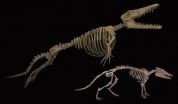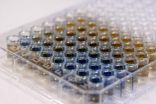(Press-News.org) Paleontology, with its rocks and fossils, seems far removed from the world of developmental genetics, with its petri dishes and embryos. Whereas paleontology strives to determine "What happened in evolution?", developmental genetics uses gene control in embryos to try to answer "How did it happen?" Combined, the two approaches can lead to remarkable insights that benefit both fields.
In the current issue of the Journal of Vertebrate Paleontology, Hans Thewissen, Ingalls-Brown Professor at Northeast Ohio Medical University (NEOMED), and his colleagues review recent studies that have used modern genetic techniques to shed light on fossils, and vice versa. "It is a very exciting time to be an evolutionary scientist. So many researchers are investigating evolution, either by finding new fossils or by figuring out the genes that underlie changes in evolution. Now it is possible to combine those two fields and go beyond what each field could have accomplished on its own," said Dr. Thewissen.
Their review discusses the profound evolutionary changes that brought about some of the more spectacular animals of today and the past, including dolphins, whales, snakes, bats, elephants, and dinosaurs. For instance, although the transition from a four-legged ancestor to something with only two forelimbs, like a dolphin, or no limbs at all, like a snake, may seem like a big leap, transitional fossils have been discovered that bridge these gaps. Additionally, using developmental genetics, researchers have come to understand that these large changes in shape involved relatively small changes in the working of just of few genes.
Perhaps even more fascinating, recent research has discovered that similarly shaped organisms may not have experienced similar developmental changes in their past. Cetaceans (whales and dolphins) and snakes both lost limbs independently from their respective ancestors through evolution, but they did so in different ways. Snakes lost their forelimbs by basically getting rid of their neck region and leaving no room for forelimbs. During snake embryonic development, no limb buds form in that region of the body. Snakes do still develop hind limb buds as embryos, but the genes that control their growth have been knocked out through the course of evolution, so hind limbs do not develop (except for small stubs in some snakes like pythons). This demonstrates that different developmental mechanisms can be at work even in the evolutionary history of a single animal. Whales and dolphins lost their hind limbs in a process similar to that of snakes.
Dr. Thewissen says, "For me personally, as someone who has spent most of his life studying fossil whales, it is very exciting to be able to use information from the development of living mammals, and use it to teach me about how whale evolution happened, 50 million years ago."
Scientists can even modify the genetic code of living animals to replicate changes that have been observed in the fossil record. As explained in the paper, it has been shown that heightened activity of a particular gene in mouse embryos causes their teeth to grow larger. A similar change occurred during the course of elephant evolution -- early elephants had teeth less than an inch long, while modern elephants have teeth over a foot in length. The genetic changes that brought about this increase in size in elephants may have resembled the ones induced in lab mice.
This sort of cross-pollination of biological disciplines was once rare but is increasingly common. The paper was co-authored with Lisa Noelle Cooper, also of NEOMED, and Richard R. Behringer of the Department of Genetics at the University of Texas MD Anderson Cancer Center. Dr. Cooper said, "At a time when most of science is hyper-specialized, my hope is that the newest generations of scientists are able and unafraid to approach research questions using a variety of techniques."
INFORMATION:
About the Society of Vertebrate Paleontology
Founded in 1940 by thirty-four paleontologists, the Society now has more than 2,300 members representing professionals, students, artists, preparators, and others interested in VP. It is organized exclusively for educational and scientific purposes, with the object of advancing the science of vertebrate paleontology.
Journal of Vertebrate Paleontology
The Journal of Vertebrate Paleontology (JVP) is the leading journal of professional vertebrate paleontology and the flagship publication of the Society. It was founded in 1980 by Dr. Jiri Zidek and publishes contributions on all aspects of vertebrate paleontology.
CITATION:
Thewissen, J.G.M., L.N. Cooper, and R.R. Behringer. 2012. Developmental biology enriches paleontology. Journal of Vertebrate Paleontology 32(6):1-12.
http://www.tandfonline.com/doi/full/10.1080/02724634.2012.707717
Recent studies bring fossils and genes together to piece together evolutionary history
2012-11-07
ELSE PRESS RELEASES FROM THIS DATE:
New method could help communities plan for climate risk
2012-11-07
CAMBRIDGE, Mass. -- Climate scientists cannot attribute any single weather event — whether a drought, wildfire or extreme storm — to climate change. But extreme events, such as Hurricane Sandy, are glimpses of the types of occurrences the world could be more vulnerable to in the future. As the devastation left by Sandy continues to reverberate, decision-makers at every level are asking: How can we be better prepared?
MIT researchers have developed a new tool to help policymakers, city planners and others see the possible local effects of climate change. Its regional projections ...
Synthetic biofilter wins through to the top 'Sweet 16' in Boston
2012-11-07
This press release is available in German.
Months of painstaking work in the laboratory at Bielefeld University's Center for Biotechnology (CeBiTec) have paid off: the 15 students participating in this year's 'international Genetically Engineered Machine competition' (iGEM) at the Massachusetts Institute of Technology (MIT) have good reason to celebrate. The goal of their project was to develop a biological filter that removes estrogen from drinking water. It was a success: they managed to produce enzymes that break down the hormone. On Monday 5 November, the competition ...
Longer use of hormonal contraception during midlife predicts better cognitive function later
2012-11-07
New Rochelle, NY, November 7, 2012—Premenopausal use of hormonal contraceptives may improve the cognitive abilities of women in midlife and for years afterward. This finding may have implications for prevention of declining cognitive function that occurs with advancing age and in diseases such as Alzheimer's. The beneficial effects of hormones increase the longer a woman uses them, as described in a study published in Journal of Women's Health, a peer-reviewed publication from Mary Ann Liebert, Inc., publishers. The article is available free on the Journal of Women's Health ...
Teva to present new Phase III data for QNASL® Nasal Aerosol at the 2012 ACAAI Meeting
2012-11-07
Contact: Denise Bradley
denise.bradley@tevapharm.com
215-591-8974
Teva North America
Teva to present new Phase III data for QNASL® Nasal Aerosol at the 2012 ACAAI Meeting
Studies highlight safety and efficacy profiles in pediatric patients with seasonal allergic rhinitis, reinforce device functionality and reliability and demonstrate ocular safety profile
JERUSALEM, Israel, November 6, 2012 – Teva Pharmaceutical Industries Ltd. announced today that additional data from the Phase III clinical program for QNASL® (beclomethasone dipropionate) Nasal Aerosol will be ...
Bone marrow stem cells do not improve short-term recovery after heart attack
2012-11-07
HOUSTON – (Nov. 7, 2012) – Administering stem cells derived from patients' own bone marrow either three or seven days after a heart attack is safe but does not improve heart function six months later, according to a clinical trial supported by the National Institutes of Health (NIH).
The results of the trial, called Transplantation In Myocardial Infarction Evaluation (TIME), mirror a previous related study, LateTIME, which found that such cells (called autologous stem cells) given two to three weeks after a heart attack did not improve heart function. Both TIME and LateTIME ...
First comprehensive guidelines for managing anaplastic thyroid cancer published in Thyroid journal
2012-11-07
New Rochelle, NY, November 7, 2012—Anaplastic thyroid cancer is a rare form of thyroid tumor, but it is also the most deadly. Newly developed evidence-based recommendations for the diagnosis, treatment, and long-term monitoring and follow-up care of patients with this extremely aggressive form of thyroid cancer are published in Thyroid (http://www.liebertpub.com/thy), a peer-reviewed journal from Mary Ann Liebert, Inc., publishers (http://www.liebertpub.com). The Guidelines, prepared by the American Thyroid Association Anaplastic Thyroid Cancer Guidelines Task Force, are ...
New cell type developed for possible treatment of Alzheimer's and other brain diseases
2012-11-07
Irvine, Calif., Nov. 7, 2012 — UC Irvine researchers have created a new stem cell-derived cell type with unique promise for treating neurodegenerative diseases such as Alzheimer's.
Dr. Edwin Monuki of UCI's Sue & Bill Gross Stem Cell Research Center, developmental & cell biology graduate student Momoko Watanabe and colleagues developed these cells –called choroid plexus epithelial cells – from existing mouse and human embryonic stem cell lines.
CPECs are critical for proper functioning of the choroid plexus, the tissue in the brain that produces cerebrospinal fluid. ...
Study shows how to reduce inappropriate shocks from implanted defibrillators
2012-11-07
MAYWOOD, Il. - Loyola University Medical Center is among the centers participating in a landmark study that could lead to fewer inappropriate shocks from implanted defibrillators.
Implanted defibrillators save lives by shocking hearts back into a normal rhythm. But sometimes a defibrillator can go off when it's not necessary, delivering a shock that feels like a kick in the chest.
The study found that reprogramming defibrillators to be less sensitive to irregular heart rhythms reduced the number of inappropriate shocks, while also reducing mortality. The study was presented ...
Researchers explore connection between popular pain relievers, bladder cancer
2012-11-07
(Lebanon, NH, 11/5/2012) — Dartmouth researchers have found that duration of ibuprofen use was associated with a reduced risk of bladder cancer in patients in northern New England, which has a high mortality rate of this disease. In a 2012 collaborative project with the National Cancer Institute, Margaret Karagas, PhD, co-director, Cancer Epidemiology & Chemoprevention program at Norris Cotton Cancer Center, and Professor of Community and Family Medicine at the Geisel School of Medicine at Dartmouth, and Richard Waddell, D.Sc, Research Assistant Professor of Medicine at ...
New drug target found for cystic fibrosis lung disease
2012-11-07
Vancouver researchers have discovered the cellular pathway that causes lung-damaging inflammation in cystic fibrosis (CF), and that reducing the pathway's activity also decreases inflammation. The finding offers a potential new drug target for treating CF lung disease, which is a major cause of illness and death for people with CF.
"Developing new drugs that target lung inflammation would be a big step forward," says Dr. Stuart Turvey, who led the research. Dr. Turvey is the director of clinical research and senior clinician scientist at the Child & Family Research Institute ...



